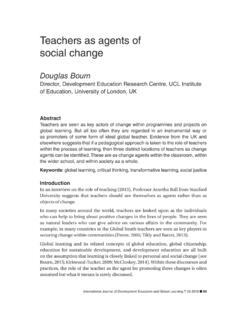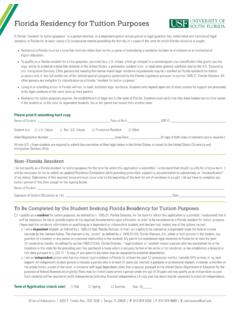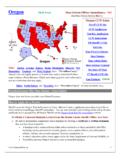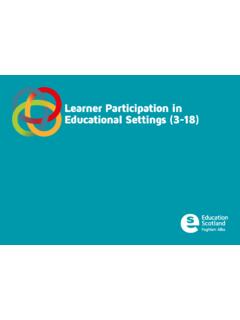Transcription of UNDERSTANDING THE PURPOSE OF HIGHER EDUCATION: …
1 2016 JEPPA VOL. 6, ISSUE 5 1 UNDERSTANDING THE PURPOSE OF HIGHER education : AN ANALYSIS OF THE ECONOMIC AND SOCIAL BENEFITS FOR COMPLETING A COLLEGE DEGREE Roy Y. Chan Indiana University, Bloomington Abstract HIGHER education worldwide is facing unprecedented challenges the dramatic rise of for-profit institutions, rapidly increasing expectations about what services colleges and universities should provide, and a complex society that demands college graduates with even more skills and capacities. To understand how HIGHER education can effectively address these challenges, this paper investigates the public and private PURPOSE of HIGHER education and what it means for HIGHER education s future. Utilizing Critical Interpretive Synthesis (CIS) and signaling theory, this research reviews the changing meanings of public and private in HIGHER education from the perspective of (1) education providers and (2) undergraduate students.
2 A comprehensive search of the literature selected 60 peer-reviewed journal articles and twenty-five books published between 2000 and 2016. Nine synthetic constructs of the goals were found and while there was some agreement between institutions and students on the economic and social benefits of HIGHER education , the review was characterized by a significant misalignment. The findings suggest that student expectations for a college degree tends to be very instrumental and personal, while HIGHER education PURPOSE of undergraduate education tend towards highly ideal life- and society-changing consequences. This paper offers eight recommendations for policymakers to consider that address the growing misalignment gap between education providers and undergraduate students. The ultimate goal is to develop renovation or repurposing strategy across competing imperatives and to outline success measures to critically define, measure, and evaluate the achievement of specific goals and outcomes in hopes of resolving potential skills mismatch in a world of massive cataclysmic change.
3 2016 JEPPA VOL. 6, ISSUE 5 2 INTRODUCTION Over the last half-century, new pressures have challenged the traditional PURPOSE and civic mission of HIGHER education (The National Task Force, 2012). On one hand, one would argue that the PURPOSE of HIGHER education tends is to acquire new knowledge and to prepare one for the workforce. On the other hand, one would also argue that institutions of HIGHER education should be aiming for more ideal contributions to the commonwealth society. That conundrum has posed persistent dilemmas about the public PURPOSE and function of HIGHER education in the 21st century (Abowitz, 2008; Brighouse & Mcpherson, 2015; Dungy, 2012; Levine, 2014; Shapiro, 2005). To enumerate, HIGHER education in the United States and abroad is facing unprecedented challenges on a wide number of issues including support for financial aid, rapidly increasing tuition rates, diminishing appropriations, modified governance relationships, and a complex and global society that demands college graduates to acquire more skills and capacities (Bastedo, Altbach, & Gumport, 2016; Goodchild, Jonsen, Limerick, & Longanecker, 2014).
4 Notably, both public and private universities are in a marketplace shift where they need to constantly prove their value and worth in contemporary society (Bok, 2003; Suspitsyna, 2012). Historically, institutions of HIGHER education exist to educate students for lives of public service, to advance knowledge through research, and to develop leaders for various areas of the public service (American Council on education , 1949). Today s universities, however, are required to prepare graduates with the knowledge, skills, and ethical responsibility to meet the future workforce needs of society and to participate fully in the new global economy (Spellings Commission, 2006). These profound changes, in turn, have shifted HIGHER education worldwide from once a public good to now a private benefit (Filippakou & Williams, 2014; Pusser, 2006), whereby colleges and universities have begun to operate as a corporate industry with predominant economic goals and market-oriented values (Gumport, 2000; Kerr, 1994; Thompson, 2014), which has reduced HIGHER education to a transactional process rather than maintaining its transformative potential (Bylsma, 2015).
5 This dual role has resulted in the rise of the new industrial model of privatization, commercialization, and corporatization and has altered HIGHER education s traditional mission, and has also increased the mission differentiation in HIGHER education systems in preparing all graduates for democratic participation, active citizenship , and personal development (Kezar, 2004; Lambert, 2014). In other words, colleges and universities are not only under pressure to promote college access, affordability, and completion in today s uncertain future, but also enhance individuals core competencies and dispositions ( , non-economic benefits), such as: the ability to think logically, the capacity to challenge the status quo, and the desire to develop sophisticated values for entry into the highly competitive global labor market (Brennan, Durazii, & Sene, 2013; Selingo, 2016; Tilak, 2008; Washburn, 2005).
6 Today s labor market requires highly skilled personnel at all levels to deal with rapid industrialization in rapidly changing environments (Ramley, 2014b). To meet current societal needs, HIGHER education institutions must redefine and reinvent college curriculum, pedagogy, and assessment policies to ensure that all students have the desired attributes and competencies to contribute to the global economy and engage effectively in democracy (Fein, 2014; Kirst & Stevens, 2015). Statistically speaking, Hart Research Associates (2015) concluded that 91 percent of employers think that critical thinking, communication, and problem-solving abilities are more important than a potential employee s undergraduate major. At the same time, 87 percent of employers give hiring preference to college graduates who have completed a senior 2016 JEPPA VOL.
7 6, ISSUE 5 3 project. While 97 percent of good jobs created since 2010 have gone to college graduates (Carnevale, Jayasundera, & Gulish, 2015), more than half of employers still report having difficulty finding qualified candidates for job openings, and over one-third say that recent graduates are very unprepared for their job searches (Carnevale, Jayasundera, & Repnikov, 2014; Carnevale, Hanson, & Gulish, 2013; Fischer, 2014; McKinsey & Company, 2015). Accordingly, new research that investigates the public and personal or private PURPOSE of HIGHER education is needed to understand the extent that students develop the discipline-specific competencies and HIGHER -level learning outcomes that are needed to live responsibly in an increasingly diverse democracy and in an interconnected global community (Roksa & Arum, 2015). Just as Saichaie and Morphew s (2014) and Watty s (2006) study helped us appreciate the tension between how academics and government policies view HIGHER education , an analysis that compares and contrasts the personal or private PURPOSE (s) of HIGHER education may help educators better understand the current disconnect between HIGHER education institutions and college graduates (McClung, 2013; World Bank, 2012).
8 If research institutions and students do not have aligned goals and aims for completing a bachelor s degree, then there is likely to be disappointment on both sides. On one hand, academics and staff may be disappointed if students do not go beyond the minimum requirements in their engagement with learning tasks. On the other hand, students may balk at learning outcomes that have little connection with vocations. Consequently, new empirical research that makes a thorough comparison between education providers and college students on the economic and social benefits of completing HIGHER education may add-value for institutions seeking to position themselves for success (Watson, 2014). This research gap stands in stark contrast to the large number of recent studies, which have examined the significant economic benefits ( , societal/direct benefits to citizens) for completing a college degree through the perspective of human capital theory (public and private or personal benefits) and new growth theory as noted within several education policy reports by Columbia University s Center for Analysis of Postsecondary education and Employment (CAPSEE) and Georgetown University s Center on education and the Workforce (Avery & Turner, 2012; McArthur, 2011; Psacharapoulos & Patrinos, 2004).
9 For instance, Carnevale and Rose (2015) found that college-educated workers with a bachelor s degree now produce more than half of the nation s annual economic value. Similarly, Benson, Esteva, and Levy (2013) found that a bachelor s degree program from California s HIGHER education system still remains a good investment for individuals and society. Likewise, Hout (2012) argued that individuals who complete HIGHER education are twice as likely to earn more money, live healthier lives, and contribute to the socio-economic and well-being of society. Consequently, completing a bachelor s degree is good for the economic health of the nation and that going to college is good for the economic competitiveness of society (Delbanco, 2012, p. 25). Given the well-established financial and career benefits of a bachelor s degree, it is plausible to suggest that a motivator for entry into and completion of undergraduate education is access to such economic and social benefits ( , reduced crime rates, increased charitable giving, HIGHER salaries and work benefits, improved health, advanced knowledge) (Zaback, Carlson, & Crellin, 2012).
10 While not an inappropriate motivation to examine the economic benefits of a college as a result of the changing global economy, research that focuses solely on the economic instrumentality of HIGHER education may not produce the best learning outcomes and competencies across the full range of college majors and institutions (Wolf, 2003). 2016 JEPPA VOL. 6, ISSUE 5 4 For example, Arum and Roksa (2011) claimed that undergraduate education make little difference in students ability to synthesize new knowledge and put complex ideas in writing. They argued that 40 percent of the 32,000 students surveyed made no gains in their writing, complex reasoning, or critical-thinking skills, and 36 percent failed to show any improvement over the four years of college (Arum & Roksa, 2014; Council for Aid to education , 2014). The authors Arum and Roksa (2011)) concluded that drifting through college without a clear sense of PURPOSE is readily apparent for undergraduates (Liu, Bridgeman, & Adler, 2012, p.

















